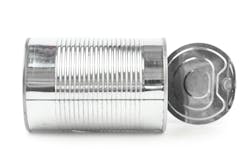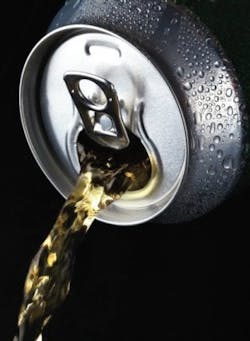New metal can coating technology offers a replacement for epoxy-based resins
Though it may seem commonplace, the metal can is an underrated hero of the modern marketplace. Its design was conceived as a means of preserving food supplies for Napoleon’s army in the late 1700s rendering it a heroic technology from day one. Fast forward a couple of centuries and canning remains a process that holds contemporary life together. Today, metal can manufacturing is a major economic force in the U.S. as a nearly $8 billion industry. In light of this, safety within mass production is of vital concern, making the coating on the inner lining of cans significant. The inner lining is expected to perform a delicate balancing act: Protect a can’s contents from contamination and protect the can itself from corrosive materials in the food or beverage a can holds.
For the past 40 years, the metal packaging industry completely relied on epoxy-based technologies for its can lining coatings. In a world where the news cycle is 24/7 and the latest trends evolve frequently, domination by a single technology for nearly half a century is atypical. That fact alone was enough to get the scientists at Dow thinking about how metal can coatings could be improved. The creation of CANVERA Polyolefin Dispersions as a long-term can coating technology was fueled not by innovation for the sake of innovation but because of a distinct “perfect storm” in the market that demanded a new technology that offered benefits across the entire metal packaging supply chain.
A growing opportunity
Modern consumer demands for healthier, safer and more sustainable products are continuing to grow and influence purchasing decisions. In fact, the business and economic case for switching to safer chemicals in the manufacturing process is strong. According to a report by Trucost on behalf of the American Sustainable Business Council and the Green Chemistry & Commerce Council, the global market for green chemistry innovation is projected to grow from around $11 billion to $100 billion by 2020. This increase, along with the sheer size of the metal can industry, was a key motivator for Dow’s research and development team to develop and offer a differentiated lining option.
Each year, more than 300 billion beverage cans are produced globally. In 2013, worldwide sales of beverage cans reached nearly $30 billion. In the Global Canned Food Market study by NOVONOUS, the compound annual growth rate (CAGR) of canned food, in particular, was estimated to be around 4.79 percent through 2020. For coatings, a 2011 study conducted by the Food Packaging Forum estimated global production of can coatings to be 800,000 metric tons, corresponding to $3.1 billion in market value. The cost of corrosion in this market globally is equivalent to 3 to 4 percent of the gross domestic product (GDP), making coating efficiency a cost-saving factor.
Currently, epoxy-based coatings hold 90 percent of the total market. Conventional epoxy-based coatings, however, require the use of certain chemicals of concern for many consumers and brand owners. One such chemical is bisphenol-A, also known as BPA. Due to a growing concern around this and other chemicals, governmental regulations surrounding its use are being instated on a global scale, including the Proposition-65 bill in California, Europe’s REACH restrictions and the total banning of BPA from use in food manufacturing in France.
These tightening regulations, along with the shift in consumer preferences, growth of opportunity in green chemistry and expansion of food and beverage packaging markets, have poised the industry for a disruptive technology. From inception, the new polyolefin dispersions were designed to maintain top marks in can coating qualities: adhesion, corrosion-resistance, flexibility, sturdiness, and flavor preservation, while also introducing a more environmentally friendly profile than their epoxy-based counterparts and eliminating the use of chemicals of concern such as epoxy, BPA, styrene and phenol-formaldehyde cross-linkers.
Benefits of polyolefin dispersions for metal can coating
Polyolefin dispersion technology offers benefits at each stage of the metal packaging manufacturing process. For food and beverage brand owners, the coating technology contributes positively to food and flavor profile, adhesion, corrosion protection and flexibility while omitting materials of concern for consumers and government regulatory bodies.
For the can maker, polyolefin dispersion technology mitigates the risk associated with production inefficiencies that often result from switching to an alternative lining technology. There is no need for new equipment or downtime because the technology is an easy, drop-in option.
For coatings formulators, this technology is listed with the FDA via the Inventory of Effective Food Contact Substance (FCS) Notifications process with corresponding Food Contact Notifications (FCN) to facilitate the manufacture of food contact compliance coatings. It has also achieved regulatory approvals globally for direct food contact. All the polymers and additives used in the dispersions are listed on the U.S. Toxic Substances Control Act (TSCA) Chemical Substance Inventory.
Proof is in the pilot
To fully realize this new technology, pilot plants were designed and constructed to mimic can manufacturing equipment used in most facilities today. During the pilots, each independent factor of the manufacturing process and stringent need of the coatings manufacturers, from specific equipment to scalable application, was considered and addressed to effectively determine if the waterborne dispersion of polyolefin would suffice for the industry.
The technology offers coatings manufacturers a replacement for epoxy-based resins because it can be applied with the same equipment. Because of the water-based coating technology, the dispersions can be spray-applied to a preformed metal can or roller coated to flat metal sheets that are then formed into cans.
Borrowing from thermoplastic processing
For decades, the flexible and rigid plastic packaging industry has relied upon a mechanical-based thermoplastic process to create its coatings. Thermoplastic processes avoid an in-situ chemical reaction that can lead to potentially dangerous extractable compounds by molding high-molecular weight, semi-crystalline polyolefins in a molten phase, rather than by reaction during baking. In contrast, thermosetting technology, which is used to create traditional epoxy-based coatings, requires that in-situ chemical reaction. The results of thermoplastic processing offer many benefits including a variety of adjustable performance properties; they are aesthetically pleasing and have a higher-impact resistance profile; and they offer a wider range of surface options than their thermosetting counterpart. The chief draw for thermoplastic technology, however, is its eco-friendly manufacturing. Few to zero volatile organic compounds are released during the process, resulting in a healthier workplace and higher level of sustainability throughout production. Each of these attributes compounded make it a favorable coating technology overall.
Translating the preferred thermoplastic technology to the metal packaging industry, however, was previously thought to be impossible. Viscous, melted polyolefin is not compatible with existing equipment used to create incumbent metal can coatings, as this equipment requires a liquid-applied coating. Completely refitting entire facilities with new equipment to introduce this technology would not only be a lengthy process, resulting in significant production downtime, but a costly one.
In addition, most polymer dispersion coatings derived from polyethylene or polypropylene, though noted for their ease of application, are hydrophobic in nature. To create a uniformly dispersed aqueous emulsion from high-molecular weight polyolefins is an incredible feat. To accomplish this while helping the dispersion to be liquid-applied would offer the metal packaging industry the ability to utilize a new, long-term coating technology in the place of epoxy.
Two factors had to be in place to achieve this. The first was a rigorous understanding of polymer architecture and innovative polymer technology for specifically designed polyolefin resins. Second, a new process needed to be invented to allow polyethylene or polypropylene to form into waterborne emulsion. Dow created its proprietary BLUEWAVE technology to accomplish this.
Ride the wave
Traditionally, for use in flexible and rigid packaging, polyolefin pellets are melted and transformed into films through extrusion and molding processes. With BLUEWAVE technology, these bulk polymers can be dispersed in water and supplied as a liquid solution, allowing them to be used in large scale and rapid mass production as a very thin coating. The technology makes a very thin, protective, thermoplastic lining with excellent food and flavor retention, adhesion, corrosion protection and film flexibility. Its distinct waterborne dispersion means food and beverage brand owners can use existing can-making infrastructure with this technology.
In the thermoplastic mechanical dispersion process, two distinct systems work in tandem to offer the proper circumstances for uniform polyolefin dispersions: a high-shear mixer and specially designed high-temperature dispersant systems. The resulting polymer particles are about 1 micron in diameter and are suspended in water. When that water is removed during the baking step of the coating process, the particles melt into a continuous defect-free thin film coating inside the can. This process avoids the extensive chemical reactions that occur during thermoset processes, lending to a better environmental health and safety profile of the end product.
Conclusion
Since its creation, the polyolefin dispersion technology has been used to coat millions of cans for a wide variety of applications worldwide. The technology’s early success increases the likelihood of rapid adoption. It offers significant operational benefits that offset the higher costs often associated with new and disruptive technologies. For more than 40 years, epoxy technology was the preferred can option. But with better performance, polyolefin dispersion technology gives the metal packaging industry and its consumers a safer, more sustainable, long-term alternative, showing that the metal can still can.
Author’s note: CANVERA™ and BLUEWAVE™ Technology are registered trademarks of Dow. CANVERA technology has received an R&D 100 Award, Business Intelligence Group’s Sustainability Product of the Year Award, ICIS Innovation Award for Best Product Innovation and the 2017 Edison Award for Breakthrough Technologies.
Jan Weernink is global business director with Dow Coating Materials. In this role, Weernink is responsible for the global metal packaging business, including the global strategy development, market implementation plans, portfolio management and manufacturing. Prior to this role Weernink was marketing director EMEAI with Dow Coating Materials. Weernink holds a Master of Business Administration and a Bachelor of Science degree in chemical engineering as well as marketing.


